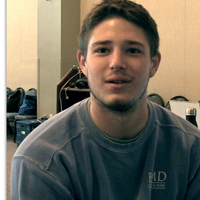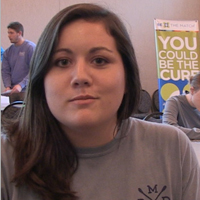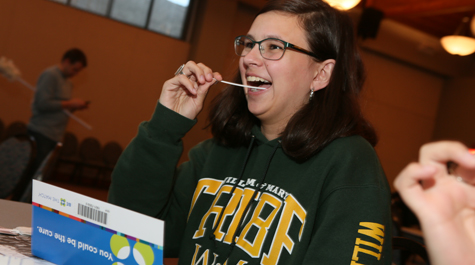Bukzin bone marrow drive turns 25
William & Mary’s “Be The Match” organization knows how to celebrate an anniversary.
The organization behind the Alan Bukzin Memorial Bone Marrow Drive recently commemorated its 25th anniversary with a one-day program that netted 176 new recruits. They arrived at the Sadler Center at all hours of the day prepared to provide a DNA sample and hoping to be a match for someone suffering from a blood-cancer disease. If that proves to be the case, they’ll have the option of donating their marrow to that person in the hope that it will cure them.
“I think when you get called you know right away if you’re going to do it or not,” Troy Thomas ’16 said. “Most people would do it if they got called. It’s the right thing to do. It’s not really that big an inconvenience. I mean, you’re saving someone’s life. It’s definitely worth it.”
Thomas, co-president of the bone marrow club, has first-hand experience in such matters. He provided a DNA sample by swabbing the inside of his mouth in his freshman year. During his first semester as a sophomore, he received a call that he was a match.
For five days leading up to his donation, he was given injections of a medication that increased the number of blood-forming cells in his bloodstream. On the day of donation, blood was removed through a needle on one arm and passed through a machine that separated out the blood-forming cells. The remaining blood was returned to him through the other arm.
“The biggest misconception is that’s an invasive, painful process,” Thomas said. “It’s not.”
Although donors and recipients sometimes meet, there is a required waiting period of one or more years and both the donor and patient must consent to being contacted.
{{youtube:medium:center|sbNX6StdZ1k, 25 years later, Bukzin drive remains strong}}
W&M wasn’t the first university to organize bone-marrow drives, but it may boast the longest continuous program and it is among the nation’s most respected.
“We’ve just taken the playbook from William & Mary and said, ‘How can we grow this?” said Dan Gariepy, community engagement representative for the National Marrow Donor Program.
Gariepy, who represents Virginia and is headquartered in Richmond, added, “West Coast, Midwest, East Coast, South: Schools all over the place are doing what W&M has created. I go places and say I’m from Virginia, and people ask me, ‘Tell me what William & Mary is doing. We want to know.’”
The university’s involvement in seeking bone-marrow donors began in 1991 as a way to find a potential match for a professor on campus. It intensified when Jay Bukzin ’94 began searching for a match for his brother, Alan, and it has never flagged.
“Our drive has a lot of passion and I think that comes from the fact that our school is big on tradition,” said Lindy Sellew ’16, bone marrow club co-president . “It was a huge thing in the late 90s, early 2000s before our school got so many more organizations. We have hundreds and everyone is splitting their time between those. I think it’s the passion people have when they hear about the cause. It’s also this underdog cause, because people don’t know much about bone marrow donation.”
According to Bethematch.org, 70 percent of patients who need a transplant do not have a matched donor in their family. They depend on the organization and its supporters to find a match to save their lives.
“My mom had Hodgkin’s Lymphoma, which luckily is a pretty curable thing,” Sellew said. “I was very young at the time and I don’t know much about it other than it caused my parents to be very proud of my involvement in this.”
Sellew has not been found to be a match yet, which is frustrating.
“I really want to be that match so I can make a difference,” she said. “I’m like, ‘I want to help,’ but I’m doing what I can by doing the drive.”
















